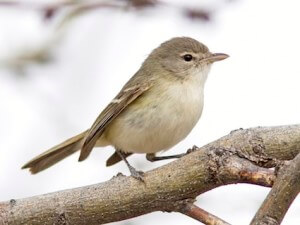The Bell’s Vireo (Vireo bellii) is listed as a threatened bird species in Wisconsin. It prefers dense shrubby areas within an open prairie landscape and is found at Badger Army Ammunition Plant. Photograph by Joan Gellatly.
The Badger Army Ammunition Plant property contains a mix of grasslands with small remnants of native prairie, scattered oak woodlands, farm fields, and idle buildings. It currently hosts some of largest populations of grassland birds in southern Wisconsin – 103 bird species have been recorded here, of which 21 have critical status in our state. With the Baraboo Hills adjacent to the north, the Badger lands provide a rare continuum of grassland to oak forest.
The first significant biological inventory of Badger in 1993 identified 16 remnants of natural communities including prairie, oak savanna, dry forest, southern hardwood swamp, pine relict, acid bedrock glade, and sandy meadow. Nearly 600 plant species were identified including 10 rare species. In addition, 25 species of butterflies, 137 aquatic insects including 6 new county records, 15 mammals, and 16 herptiles (reptiles and amphibians) were identified on the Badger plant property.
The Badger biological inventory was the result of a nationwide agreement between the Nature Conservancy and the Department of Defense. The Conservancy’s work was financed by a $45,000 allocation from the federal Legacy Resource Management Program and was designed to promote the management and restoration of biological and cultural resources of Defense Department lands.
Many of the species identified at the Badger plant are found in places with such unlikely names as the Rocket Area, the Magazine area, the Acid area, the Propellant Burning grounds, the nitroglycerine pond and the Cannon range. Most of these plant and animal species occupied the prairie long before the Badger plant was built in 1942.
A major discovery of the 1993 survey was the federally threatened prairie bush clover. The bush clover and purple milkweed, Wisconsin endangered species, and at least six threatened species including the slender bush clover, the drooping sedge, the wild quinine and round-stemmed false foxglove were found at Badger.
Not surprisingly, most of the nesting birds were found in areas that are lightly grazed and see very little human activity. The diversity and variety of ponds within the plant – including old farm ponds and glacial remnant kettle ponds – support aquatic diversity ‘never found before’ in Sauk County. Among the species found was a boreal aquatic beetle previously found in only four northern counties.
Unfortunately, the purpose of the inventory was not to develop a management plan but simply to identify the natural resources within the facility. Without a management and preservation plan, the future of these natural resources remained uncertain.
REFERENCES:
Wisconsin Department of Natural Resources, Regional & Property Analysis: Sauk Prairie Recreation Area, July 2012.
Wisconsin’s Natural Heritage Inventory Program, Bureau of Endangered Resources, Rapid Ecological Assessment for the Sauk Prairie Recreation Area, December 2011.


